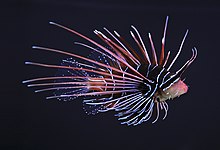Loading AI tools
Species of fish From Wikipedia, the free encyclopedia
The clearfin lionfish (Pterois radiata), also called the tailbar lionfish, radiata lionfish, fireworks fish or radial firefish, is a carnivorous, ray-finned fish with venomous spines belonging to the family Scorpaenidae, the scorpionfishes and lionfishes. This species lives in the Indian and western Pacific Oceans. This is the only lionfish species which has spines without any markings. It can also be recognized by the pair of horizontal white stripes on its caudal peduncle.
| Clearfin lionfish | |
|---|---|
 | |
| Scientific classification | |
| Domain: | Eukaryota |
| Kingdom: | Animalia |
| Phylum: | Chordata |
| Class: | Actinopterygii |
| Order: | Scorpaeniformes |
| Family: | Scorpaenidae |
| Genus: | Pterois |
| Species: | P. radiata |
| Binomial name | |
| Pterois radiata G. Cuvier, 1829 | |
| Synonyms[2] | |
The clearfin lionfish was first formally described in 1829 by the French zoologist Georges Cuvier with the type locality given as Tahiti.[3] The specific name radiata means "radiated" or "rayed", thought to be an allusion to the long pectoral-fin rays, which are free of fin membrane distally.[4]
The clearfin lionfish grows to a length of about 24 cm (9 in), though a more usual size is 20 cm (8 in). The dorsal fin has 12 or 13 long, venomous spines and 10 to 12 soft rays. The anal fin has three spines and five or six soft rays. The large pectoral fins flare out to the side and are clear and unbanded. The other fins are also colourless. The head and body colour is reddish-brown with about six vertical dark bands of different colour on the body separated by thin white lines. Two white horizontal lines occur on the caudal peduncle which distinguishes this fish from other similar lionfishes.[2][5]
Clearfin lionfish are native to the western Indo-Pacific region. Its range extends from South Africa and the Gulf of Aden to Indonesia, the Society Islands, the Ryukyu Islands, northern Australia, and New Caledonia. It is found on both inshore and offshore rocky reefs at depths to about 25 m (82 ft). Juvenile fish are sometimes found in tide pools.[5]
The clearfin lionfish is mainly nocturnal. It spends the day hiding in rock crevices, in small caves, or under overhangs. It emerges at night to feed on invertebrates such as crabs and shrimps.[2]
Seamless Wikipedia browsing. On steroids.
Every time you click a link to Wikipedia, Wiktionary or Wikiquote in your browser's search results, it will show the modern Wikiwand interface.
Wikiwand extension is a five stars, simple, with minimum permission required to keep your browsing private, safe and transparent.